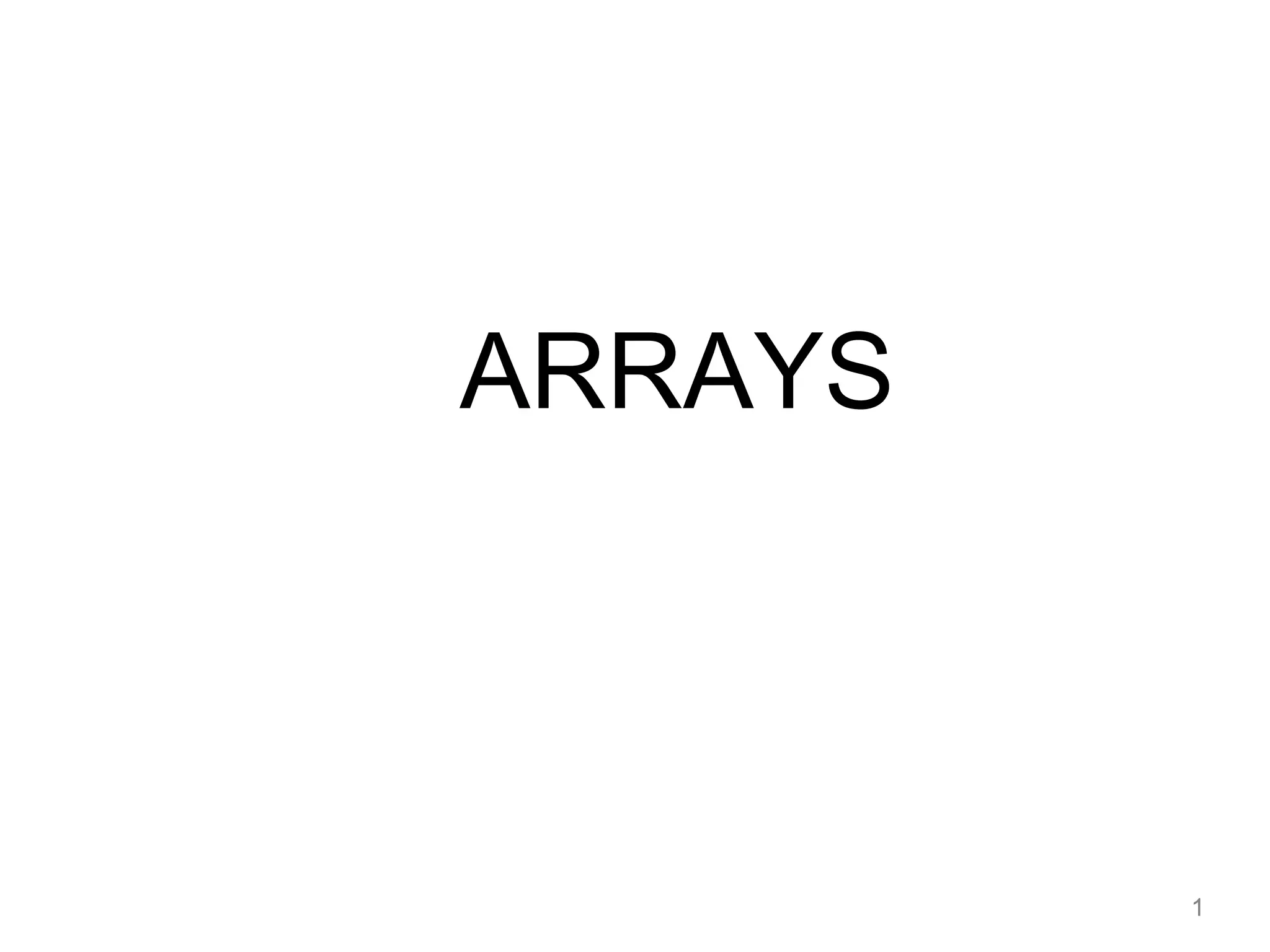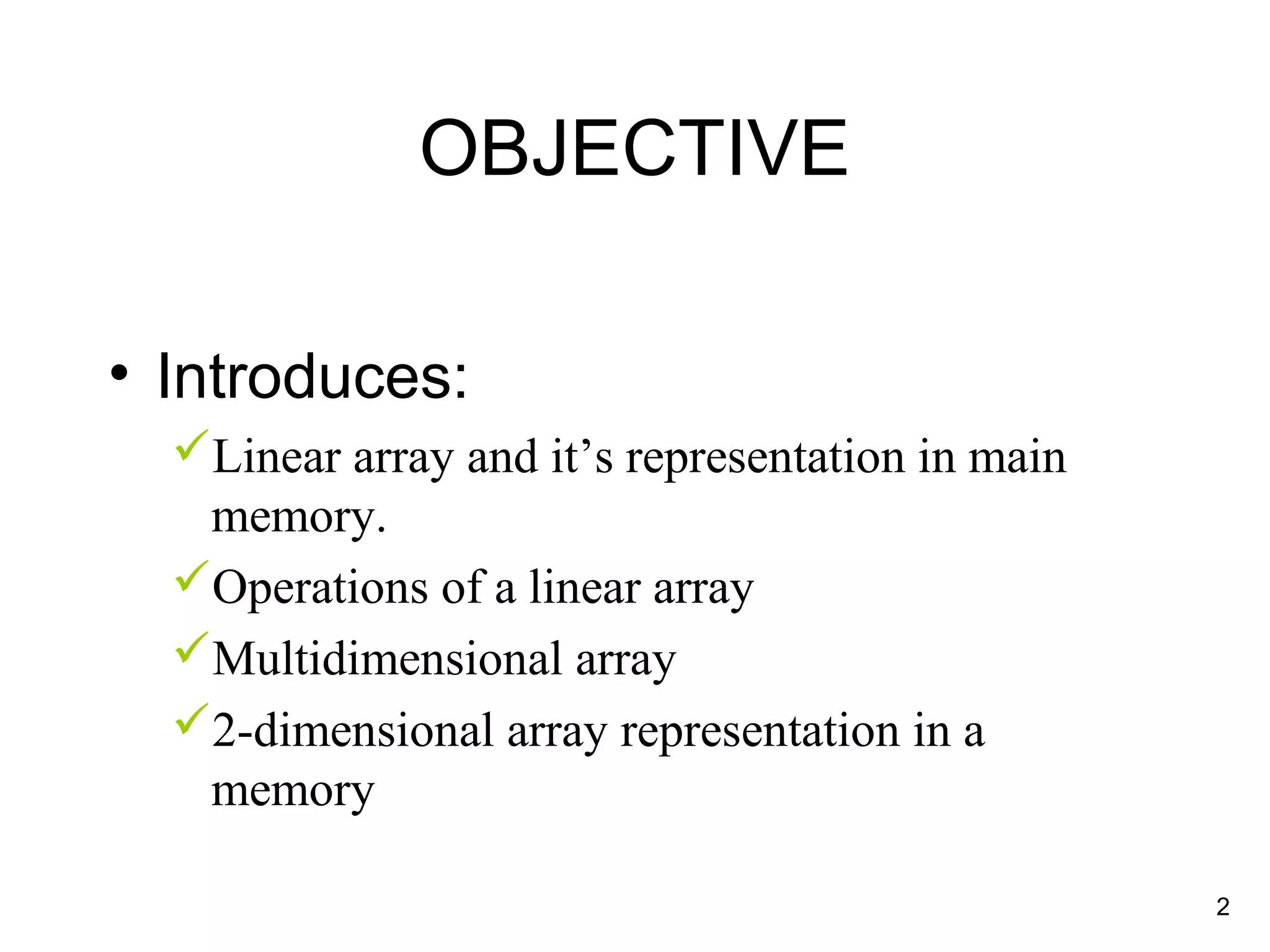The document discusses arrays and their representation in memory. It contains 3 main points:
1) It introduces linear arrays and how they are represented in memory with sequential and contiguous locations. It also discusses multidimensional arrays.
2) It provides algorithms for common linear array operations like traversing, inserting, deleting and searching using binary search. It explains how each algorithm works through examples.
3) It discusses how 2D arrays are represented in memory and visualized, using an example of storing student exam marks in a 2D array.






![7
Linear Array
• All elements in A are written symbolically as, 1 .. n is the
subscript.
A1, A2, A3, .... , An
• i.e., FORTRAN, PL/1 and BASIC A(1), A(2), ..., A(N)
Java A[0], A[1], ..., A[N-1] , subscript starts from 0
LB = 0, UB = N–1](https://image.slidesharecdn.com/array2-150104005957-conversion-gate02/75/Array-2-7-2048.jpg)
![8
Representation of Array in a Memory
• The process to determine the address in a memory:
a) First address – base address.
b) Relative address to base address through index function.
Example: char X[100];
Let char uses 1 location storage.
If the base address is 1200 then the next element is in 1201.
Index Function is written as:
Loc (X[i]) = Loc(X[0]) + i , i is subscript and LB = 0
1200 1201 1202 1203
X[0] X[1] X[2]](https://image.slidesharecdn.com/array2-150104005957-conversion-gate02/75/Array-2-8-2048.jpg)
![9
Traversing Algorithm
Traversing operation means visit every element once.
e.g. to print, etc.
Example algorithm:
1. [Assign counter]
K=LB // LB = 0
2. Repeat step 2.1 and 2.2 while K <= UB // If LB = 0
2.1 [visit element]
do PROCESS on LA[K]
2.2 [add counter]
K=K+1
3. end repeat step 2
4. exit](https://image.slidesharecdn.com/array2-150104005957-conversion-gate02/75/Array-2-9-2048.jpg)

![11
Insertion Algorithm
Example algorithm:
INSERT(LA, N, K, ITEM)
//LA is a linear array with N element
//K is integer positive where K < N and LB = 0
//Insert an element, ITEM in index K
1. [Assign counter]
J = N – 1; // LB = 0
2. Repeat step 2.1 and 2.2 while J >= K
2.1 [shift to the right all elements from J]
LA[J+1] = LA[J]
2.2 [decrement counter] J = J – 1
3. [Stop repeat step 2]
4. [Insert element] LA[K] = ITEM
5. [Reset N] N = N + 1
6. Exit](https://image.slidesharecdn.com/array2-150104005957-conversion-gate02/75/Array-2-11-2048.jpg)


![14
Deletion Algorithm
Example algorithm:
DELETE(LA, N, K, ITEM)
1. ITEM = LA[K]
2. Repeat for I = K to N–2 // If LB = 0
2.1 [Shift element ke J + 1, forward]
LA[I] = LA[I+1]
3. [end of loop]
4. [Reset N in LA]
N = N – 1
5. Exit](https://image.slidesharecdn.com/array2-150104005957-conversion-gate02/75/Array-2-14-2048.jpg)


![17
Binary Search Algorithm
• Target found case: Assume we want to find 22 in a sorted
list as follows:
• The three indexes are first, mid and last. Given first as 0 and
last as 11, mid is calculated as follows:
mid = (first + last) / 2
mid = (0 + 11) / 2 = 11 / 2 = 5
4 7 8 10 14 21 22 36 62 77 81 91
a[0] a[1] a[2] a[3] a[4] a[5] a[6] a[7] a[8] a[9] a[10] a[11]](https://image.slidesharecdn.com/array2-150104005957-conversion-gate02/75/Array-2-17-2048.jpg)
![18
Binary Search Algorithm
• At index location 5, the target is greater than the list value (22 > 21).
Therefore, eliminate the array locations 0 through 5 (mid is automatically
eliminated). To narrow our search, we assign mid + 1 to first and repeat
the search.
4 7 8 10 14 21 22 36 62 77 81 91
a[0] a[1] a[2] a[3] a[4] a[5] a[6] a[7] a[8] a[9] a[10] a[11]
0 5 11
first mid last
Target: 22Target: 22
22 > 21](https://image.slidesharecdn.com/array2-150104005957-conversion-gate02/75/Array-2-18-2048.jpg)
![19
Binary Search Algorithm
• The next loop calculates mid with the new value for first and
determines that the midpoint is now 8 as follows:
mid = (6 + 11) / 2 = 17 / 2 = 8
4 7 8 10 14 21 22 36 62 77 81 91
a[0] a[1] a[2] a[3] a[4] a[5] a[6] a[7] a[8] a[9] a[10] a[11]
6 8 11
first mid last
Target: 22Target: 22
22 < 62](https://image.slidesharecdn.com/array2-150104005957-conversion-gate02/75/Array-2-19-2048.jpg)
![20
Binary Search Algorithm
• When we test the target to the value at mid a second time, we discover that the
target is less than the list value (22 < 62). This time we adjust the end of the list
by setting last to mid – 1 and recalculate mid. This step effectively eliminates
elements 8 through 11 from consideration. We have now arrived at index location
6, whose value matches our target. This stops the search.
4 7 8 10 14 21 22 36 62 77 81 91
a[0] a[1] a[2] a[3] a[4] a[5] a[6] a[7] a[8] a[9] a[10] a[11]
6 6 7
first mid last
Target: 22Target: 22
22 equals 228 6 7
function terminates
first mid last](https://image.slidesharecdn.com/array2-150104005957-conversion-gate02/75/Array-2-20-2048.jpg)
![21
Binary Search Algorithm
• Target not found case: This is done by testing for first and last crossing:
that is, we are done when first becomes greater than last. Two conditions
terminate the binary search algorithm when (a) the target is found or (b)
first becomes larger than last. Assume we want to find 11 in our binary
search array.
4 7 8 10 14 21 22 36 62 77 81 91
a[0] a[1] a[2] a[3] a[4] a[5] a[6] a[7] a[8] a[9] a[10] a[11]
0 5 11
first mid last Target: 11Target: 11
11 < 21](https://image.slidesharecdn.com/array2-150104005957-conversion-gate02/75/Array-2-21-2048.jpg)
![22
Binary Search Algorithm
• The loop continues to narrow the range as we saw in the
successful search until we are examining the data at index
locations 3 and 4.
4 7 8 10 14 21 22 36 62 77 81 91
a[0] a[1] a[2] a[3] a[4] a[5] a[6] a[7] a[8] a[9] a[10] a[11]
0 2 4
first mid last
Target: 11Target: 11
11 > 8](https://image.slidesharecdn.com/array2-150104005957-conversion-gate02/75/Array-2-22-2048.jpg)
![23
Binary Search Algorithm
• These settings of first and last set the mid index to 3 as follows:
mid = (3 + 4) / 2 = 7 / 2 = 3
4 7 8 10 14 21 22 36 62 77 81 91
a[0] a[1] a[2] a[3] a[4] a[5] a[6] a[7] a[8] a[9] a[10] a[11]
3 3 4
first mid last Target: 11Target: 11
11 > 10](https://image.slidesharecdn.com/array2-150104005957-conversion-gate02/75/Array-2-23-2048.jpg)
![24
Binary Search Algorithm
• The test at index 3indicates that the target is greater than the list value, so we set first to mid
+ 1, or 4. We now test the data at location 4 and discover that 11 < 14. The mid is as
calculated as follows:
• At this point, we have discovered that the target should be between two adjacent values; in
other words, it is not in the list. We see this algorithmically because last is set to mid – 1,
which makes first greater than last, the signal that the value we are looking for is not in the
list.
4 7 8 10 14 21 22 36 62 77 81 91
a[0] a[1] a[2] a[3] a[4] a[5] a[6] a[7] a[8] a[9] a[10] a[11]
4 4 4
first mid last
Target: 11Target: 11
11 < 14 4 4 3
first mid last
Function terminates](https://image.slidesharecdn.com/array2-150104005957-conversion-gate02/75/Array-2-24-2048.jpg)

![26
Binary Search Algorithm
1. [Define variables]
ST = LB, LAST= UB;
MID = (ST+LAST)/2;
2. Repeat 3 and 4 DO ST <= LAST & DATA[MID] != ITEM
3. If ITEM < DATA[MID] then
LAST = MID-1
If not
ST = MID+1
4. Set MID = INT((ST + LAST)/2)
[LAST repeat to 2]
5. If DATA[MID] = ITEM then
LOK = MID
If not,
LOK = NULL
6. Stop](https://image.slidesharecdn.com/array2-150104005957-conversion-gate02/75/Array-2-26-2048.jpg)


![29
2-D ARRAY
• Multidimensional array declaration in Java:-
int [][] StudentMarks = new int [25][4];
StudentMarks[0][0] = 88;
StudentMarks[0][1] = 78;…..
OR
int [][] StudentMarks = {{88, 78, 66, 89},
{60, 70, 88, 90},…}](https://image.slidesharecdn.com/array2-150104005957-conversion-gate02/75/Array-2-29-2048.jpg)
![30
2-D ARRAY
• In Java the 2-D array is visualized as follows:
…
[0]
[1]
[2]
[3]
[4]
[5]
[6]
[24]
StudentMarks
88 78 66 89
60 70 88 90
62 45 78 88
[0] [1] [2] [3]](https://image.slidesharecdn.com/array2-150104005957-conversion-gate02/75/Array-2-30-2048.jpg)
![31
Exercises
• Find where the indicated elements of an
array a are stored, if the base address
of a is 200* and LB = 0
a) double a[10]; a[3]?
b) int a[26]; a[2]?
*(assume that int(s) are stored in 4 bytes
and double(s) in 8 bytes).](https://image.slidesharecdn.com/array2-150104005957-conversion-gate02/75/Array-2-31-2048.jpg)